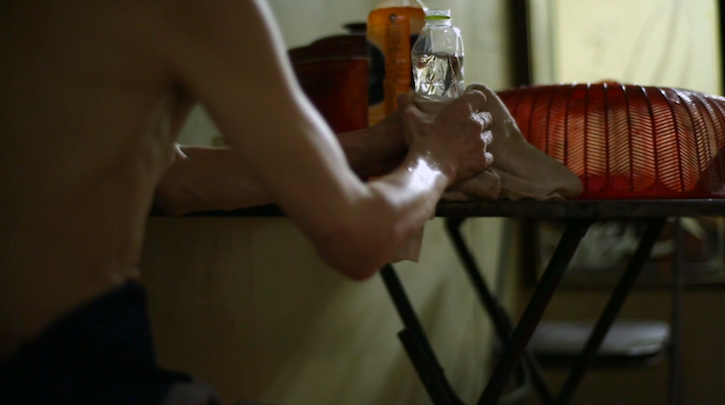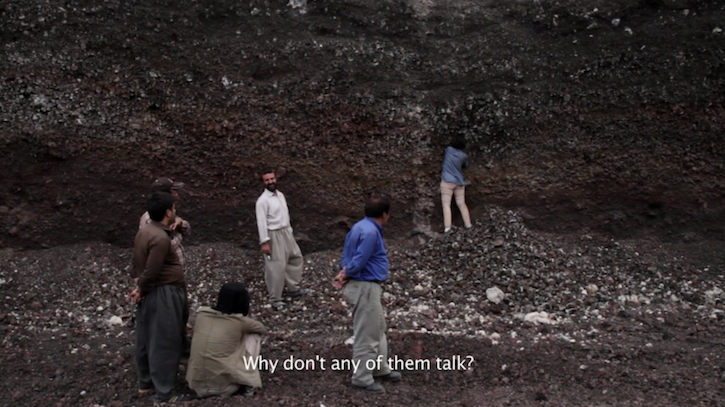The time it takes to do things with trembling hands
Sindhu Thirumalaisamy
Program notes quickly turned into paper fans as we settled into the humid auditorium at the Skowhegan School of Painting and Sculpture in Maine. We were gathered to watch films and videos made by the artists in residence. There were murmurs about the “long” film at the end of the program. Peng Zuqiang’s Nan was seventy-nine minutes long, said the notes.{1} As the lights were dimmed, the programmers consoled us that “we would get through this together.” Sighs came tenderly, as tacit acknowledgements that it was going to be an act of collective endurance. And though there are many reasons why audiences might not want to engage films with lengthy run-times, I was surprised that this reluctance showed up in a group of artists and in the exceptionally “free” time of a residency.
Zuqiang describes Nan as being about economies of care.{2} It is filmed in Changsha, China in the house where his grandparents and uncle Nan live. The dynamics of care between family members, the products they buy, and the professional health services they use are detailed in scenes of daily life. In one of the first scenes, Nan attempts to transfer boiled drinking water from one plastic bottle into another. He is determined to complete this task despite his mother’s warnings to wait till the water cools down. There was time for my thoughts to wander as the scene unfolded. I was reminded of how my grandfather would shuffle back and forth in the kitchen as he waited for my grandmother to finish preparing dinner. My grandmother, never one to rush herself, would cook at her own pace despite him repeatedly asking, “is it ready yet?” Their relationship, strained by their unchanging roles as caregiver and receiver, would often slip into petty arguments—like those between Nan and his mother. As he pours water from one bottle to another, Nan’s hands tremble. His gaze is intent, as was mine, tracing the space from the mouth of one bottle to the other. They don’t match up. Some water spills. His hands startle. I twitched. The water is scalding hot. The plastic crumples from the heat. I knew this frustration—as if time would run out. He tries again. Eventually, not perfectly but with finality, the water is transferred, and the scene ends.
 Figure 1. From NAN (2019), Peng Zuqiang. Courtesy the artist.
Figure 1. From NAN (2019), Peng Zuqiang. Courtesy the artist.
It would be easy to write about Nan as a slow film. The scene I described would be considered “long” by many standards. But I want to hold that Zuqiang’s film is neither slow nor long. It simply unfolds at the pace with which Nan and his parents move through the world—rhythms to which anyone who is invited into their life would be asked to synchronize. Several scenes in the film follow Nan’s actions in this way, sending some of our bodies out of sync. They challenge our chrononormativity.{3} We learn about dis/ability not as symptoms in a body but as social relationships—physical and temporal relationships that we become implicated in. More than discerning the plot or story, the work that we do in these scenes is about syncing with others’ rhythms. In other words, the work is durational. The film’s run-time reveals little about the duration that is produced as we move through these encounters of difference. It makes some of us restless and others more relaxed. Whispers and yawns fill the auditorium during these scenes along with the fluttering of program notes. Thoughts and memories, not quite fixed as stories, take form beyond the screen.
Watching Nan in the humid auditorium brought back other memories of a summer that I spent at home in Coimbatore. I was recovering from dengue fever. Conversation was the only thing I had the energy for those days and my grandmother was there for it. I would lay on my back and chat with her as she read, did housework, and exercised. By that time, my grandfather had died. Following his death, she developed Parkinson’s. Her hands trembled, like Nan’s. Her body bent and refused to be timely in the ways that it had needed to be when she was taking care of her husband. In this period of her life, she negotiated new ways to spend her time, working with her tremors to avoid slipping into depression. She continued to cook for us though it took her more and more time to do so. Our eating habits changed. The rhythms of life at home changed. Everyone in the family had to learn to deal with Parkinson’s even if it wasn’t showing up in “our own” bodies.
A temporal experience of fragility not bounded within one body—this is what I wanted to explore that summer when I made the video poem cada flor tiene (every flower has).{4} The work is a contribution to Lata Mani and Nicolás Grandi’s The Poetics of Fragility, a transmedia project that “reclaims fragility as intrinsic to existence, not something to be bemoaned or overcome.”{5} cada flor tiene centers the sound of my grandmother peeling banana flowers and the conversation that blooms around this action. It uses sound and text to emphasize the rhythms of our exchanges as we talk about bodies and time. Our conversation unfurls like the petals, arriving at connections between a number of things—Parkinson’s, work, nerves, air, honey, language, memory—“myriad intimacies, largely unknown.”{6} My grandmother likens the flowers to her own body as she peels them. She points out how tough they are; just like her nerves, she says. “They never soften no matter how much you cook them,” she says, making me think about the hardness of the “dur” in duration and endurance.
Excerpt from CADA FLOR TIENE (2016), Sindhu Thirumalaisamy. Courtesy the artist.
Nan and cada flor tiene resonated for me because they both engage non-normative temporalities to reveal duration as a relational experience. They invite us to consider durational work as a collective effort to move beyond bodily, temporal norms. When Shadi Harouni presented The Lightest of Stones a few weeks later in the same auditorium, it became clearer to me that such engagements with duration push against expectations for films to move us through unfamiliar worlds.{7}
The Lightest of Stones is part of a trilogy of films that are set in a pumice quarry in Iranian Kurdistan. As international sanctions crush local industries and ISIS rises to power close by, the quarry and its workers, many of whom are Kurdish dissidents, stand in heavy stillness. The camera frames the artist unearthing rocks from the side of the cavernous mountain with her bare hands. Quarry workers stand gathered behind her, providing commentary. Their comments are laced with a dry humor that has sedimented over years of censorship and suppression. They joke about Shadi’s industriousness, contrasting it with the quarry’s state of dysfunction and their own uninterest in work. Details of a collective melancholia rise and fall without hurry. The monumental mountain crumbles little by little as Shadi persistently claws at it. In spaces where censorship is normalized, absurdity and abstraction are necessary in order to speak, she said after the screening. Time is also necessary—she added—time to sit with things and to miss them. The film asks us to register that we are missing things as much as we are constructing narratives about the quarry and its workers.
 Figure 2. From THE LIGHTEST OF STONES (2015), Shadi Harouni. Courtesy the artist and Galleria Tiziana Di Caro.
Figure 2. From THE LIGHTEST OF STONES (2015), Shadi Harouni. Courtesy the artist and Galleria Tiziana Di Caro.
The spectators within the film are also doing durational work. They know that the footage will eventually be seen by audiences “in America.” They anticipate our gazes, guessing at how we might misread them. They mirror my own anxieties around not knowing where I stand in relation to what I am looking at. They joke about it. Then, a question comes up. “This is a documentary, right?” someone asks, as if the answer could give us some kind of clue about how to respond. Larger and larger rocks fall on Shadi but she continues to carve the mountain without looking back. It is her action that keeps the take going. “What kind of time is this?” one could ask. After several minutes of banter, the spectators can no longer ignore the silence of the film crew. Someone finally demands, “no, really, what kind of film is this?” The only microphone on location is pointed at them, they notice, and stop talking. The film ends but the questions remain.
What to do with experiences of shared time when they don’t reveal cohesive narratives? When, rather, what they reveal is a lack? I try to hold on to a thought: we are not obligated as filmmakers to fill in that lack, least of all, with stories. I continue to think about what Zuqiang, Shadi, and I are doing when we present these films far away from the places where we filmed them. We live and work between seemingly incommensurable contexts. How we choose to produce meaning does not rely on the assumed transmission of a story. Rather than trying to bridge the gaps between worlds with seamless storytelling, we move towards highlighting their differences. Duration is our tool to put bodily, social differences into relation. This is why I think that the time it takes to do things with trembling hands is neither slow nor long. Several things are happening when Nan is pouring water from bottle to melting plastic bottle, or when my grandmother is peeling hundreds of banana flowers that each hold two drops of honey, or when Shadi is carving into the side of a mountain. To work with duration in these moments is to sit with not-knowing, to feel a difference, and to move with it. And, sometimes, such an experience of duration is the story.
Title Video: footage courtesy of Sindhu Thirumalaisamy.
{1} Nan, dir. Zuqiang Peng (2019, digital video, 79 min).
{2} “Nan,” Peng Zuqiang.
{3} Elizabeth Freeman, Time Binds: Queer Temporalities, Queer Histories, Perverse Modernities (Durham, NC: Duke University Press, 2010), 3.
{4} cada flor tiene (every flower has), dir. Sindhu Thirumalaisamy (2016, digital video, 6 min).
{5} The Poetics of Fragility, dir. Nicolás Grandi and Lata Mani (2016, digital video, 63 min).
{6} The Autonomous Self, dir. Lata Mani, in The Poetics of Fragility (2016, digital video, 63 min).
{7} The Lightest of Stones, dir. Shadi Harouni (2015, digital video, 16 min).

